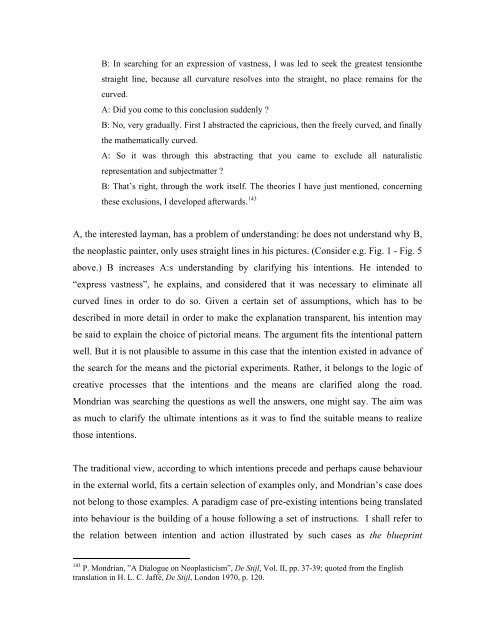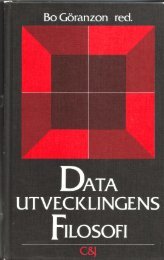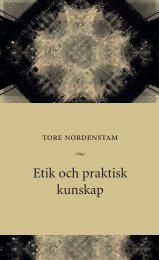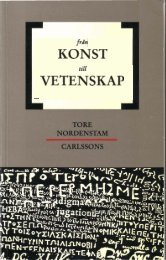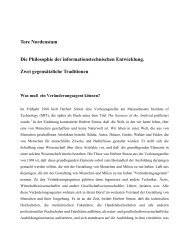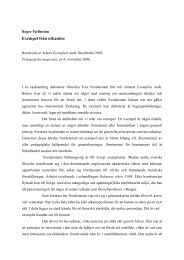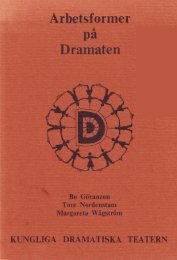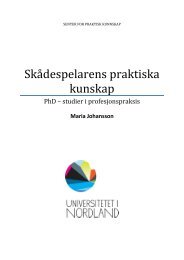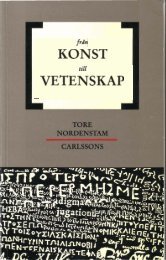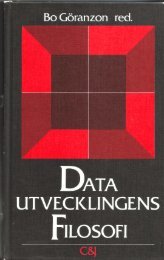tore nordenstam explanation and understanding in the history of art
tore nordenstam explanation and understanding in the history of art
tore nordenstam explanation and understanding in the history of art
You also want an ePaper? Increase the reach of your titles
YUMPU automatically turns print PDFs into web optimized ePapers that Google loves.
B: In search<strong>in</strong>g for an expression <strong>of</strong> vastness, I was led to seek <strong>the</strong> greatest tension<strong>the</strong><br />
straight l<strong>in</strong>e, because all curvature resolves <strong>in</strong>to <strong>the</strong> straight, no place rema<strong>in</strong>s for <strong>the</strong><br />
curved.<br />
A: Did you come to this conclusion suddenly ?<br />
B: No, very gradually. First I abstracted <strong>the</strong> capricious, <strong>the</strong>n <strong>the</strong> freely curved, <strong>and</strong> f<strong>in</strong>ally<br />
<strong>the</strong> ma<strong>the</strong>matically curved.<br />
A: So it was through this abstract<strong>in</strong>g that you came to exclude all naturalistic<br />
representation <strong>and</strong> subjectmatter ?<br />
B: That’s right, through <strong>the</strong> work itself. The <strong>the</strong>ories I have just mentioned, concern<strong>in</strong>g<br />
<strong>the</strong>se exclusions, I developed afterwards. 143<br />
A, <strong>the</strong> <strong>in</strong>terested layman, has a problem <strong>of</strong> underst<strong>and</strong><strong>in</strong>g: he does not underst<strong>and</strong> why B,<br />
<strong>the</strong> neoplastic pa<strong>in</strong>ter, only uses straight l<strong>in</strong>es <strong>in</strong> his pictures. (Consider e.g. Fig. 1 - Fig. 5<br />
above.) B <strong>in</strong>creases A:s underst<strong>and</strong><strong>in</strong>g by clarify<strong>in</strong>g his <strong>in</strong>tentions. He <strong>in</strong>tended to<br />
“express vastness”, he expla<strong>in</strong>s, <strong>and</strong> considered that it was necessary to elim<strong>in</strong>ate all<br />
curved l<strong>in</strong>es <strong>in</strong> order to do so. Given a certa<strong>in</strong> set <strong>of</strong> assumptions, which has to be<br />
described <strong>in</strong> more detail <strong>in</strong> order to make <strong>the</strong> <strong>explanation</strong> transparent, his <strong>in</strong>tention may<br />
be said to expla<strong>in</strong> <strong>the</strong> choice <strong>of</strong> pictorial means. The argument fits <strong>the</strong> <strong>in</strong>tentional pattern<br />
well. But it is not plausible to assume <strong>in</strong> this case that <strong>the</strong> <strong>in</strong>tention existed <strong>in</strong> advance <strong>of</strong><br />
<strong>the</strong> search for <strong>the</strong> means <strong>and</strong> <strong>the</strong> pictorial experiments. Ra<strong>the</strong>r, it belongs to <strong>the</strong> logic <strong>of</strong><br />
creative processes that <strong>the</strong> <strong>in</strong>tentions <strong>and</strong> <strong>the</strong> means are clarified along <strong>the</strong> road.<br />
Mondrian was search<strong>in</strong>g <strong>the</strong> questions as well <strong>the</strong> answers, one might say. The aim was<br />
as much to clarify <strong>the</strong> ultimate <strong>in</strong>tentions as it was to f<strong>in</strong>d <strong>the</strong> suitable means to realize<br />
those <strong>in</strong>tentions.<br />
The traditional view, accord<strong>in</strong>g to which <strong>in</strong>tentions precede <strong>and</strong> perhaps cause behaviour<br />
<strong>in</strong> <strong>the</strong> external world, fits a certa<strong>in</strong> selection <strong>of</strong> examples only, <strong>and</strong> Mondrian’s case does<br />
not belong to those examples. A paradigm case <strong>of</strong> pre-exist<strong>in</strong>g <strong>in</strong>tentions be<strong>in</strong>g translated<br />
<strong>in</strong>to behaviour is <strong>the</strong> build<strong>in</strong>g <strong>of</strong> a house follow<strong>in</strong>g a set <strong>of</strong> <strong>in</strong>structions. I shall refer to<br />
<strong>the</strong> relation between <strong>in</strong>tention <strong>and</strong> action illustrated by such cases as <strong>the</strong> bluepr<strong>in</strong>t<br />
143 P. Mondrian, ”A Dialogue on Neoplasticism”, De Stijl, Vol. II, pp. 37-39; quoted from <strong>the</strong> English<br />
translation <strong>in</strong> H. L. C. Jaffé, De Stijl, London 1970, p. 120.


